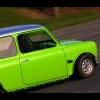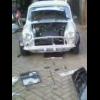After 3 coats of clear it looked a decent finish and it was left to dry in the garage for a fortnight. There was absolutely no reaction in this time. It was then wet sanded with 1200 grit, then G3 and G10 paste on an electric polisher, polished and waxed. Within minutes a few lines appeared in the paint on one area of the car which looked like hairs stuck in the laquer. As the days went by these spread throughout the car and now it is almost covered in a finish that resembles a cracked egg. It doesn't fall off or peel and seems to be just below the surface but it looks awful. I thought it was a problem with paint compatibility and took it back to the supplier. He did a test card and let me take it home to flat and polish. The same thing happened to one test but not another but he has no idea what the cause of it is.
I started my Park Lane a few weeks back and just finished the numberplate light housing as a test, this time in a pearlescent version of the same laquer and about a week after finishing a similar thing happened. The weird thing about it is that it only ever happens after the final colour-sanding and polishing and then only days after finishing that, every stage inbetween goes just fine. I am at a complete loss as to what has caused it and now have 2 unfinished Minis sitting there until I can come up with a solution!
What I will say is that the garage isn't heated constantly so it has fallen below freezing overnight at times, although spraying has been done at above 15 degrees c. It doesn't seem to have had any effect on the paint applied so far on the second project (5 coats primer/3 coats basecoat, now a month old and flatted ready for next 3 coats) Any ideas would be really helpful! Photos are available if required?
Thanks





















